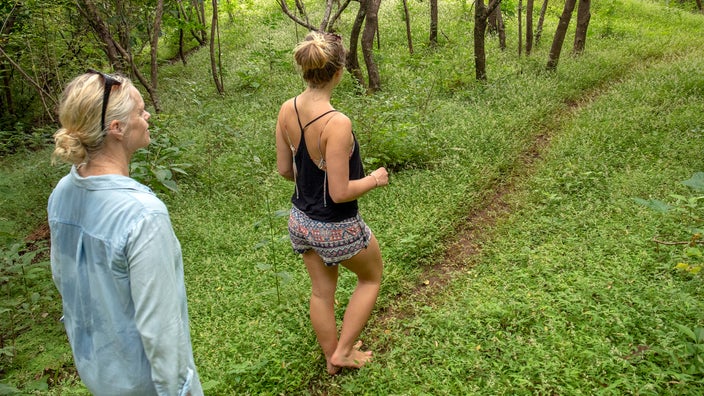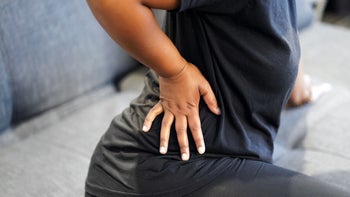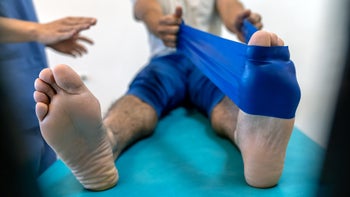
Are There Benefits to Walking Barefoot?
Key takeaways:
Walking barefoot may strengthen the foot muscles, improve balance, and reduce stress.
Barefoot walking can increase the risk of cuts and infections, such as plantar warts or athlete's foot. If you walk barefoot, avoid public sidewalks or locker rooms and stay on soft, gentle surfaces.
For older adults or those with diabetic neuropathy, minimalist footwear might be a better option than walking barefoot.

Walking barefoot has recently grown in popularity. Proponents say it benefits your body and mind. But walking barefoot has its time and place. And it's not suitable for everyone.
Humans started wearing shoes around 40,000 years ago to protect their feet from the elements. Since then, our shoes have become highly engineered with arch support, cushions, and shock absorbers. But have they become too supportive?
While there are benefits of walking barefoot, there are also risks. Here's what you need to know before you ditch your shoes.
Search and compare options
What are the benefits of walking barefoot?
Walking barefoot has been shown to have several benefits.
1. Strengthens foot and leg muscles
Research suggests that children who walk barefoot may have stronger feet and fewer toe deformities. They may also have a more developed arch than those who often wear shoes.
As we age, the muscles in our feet weaken, increasing the risk of falls. So taking a break from wearing shoes could give your foot muscles –– 29 of them, to be exact –– a workout.
But there's a need for more research on barefoot walking in people of different ages. And going shoeless isn't the only way to strengthen foot and leg muscles. Switching to less supportive shoes makes a big difference. A 2021 study had adults switch from supportive footwear to minimal footwear. After 6 months, they had a 57% increase in foot strength.
2. Improves foot mechanics and ankle range of motion
Walking barefoot lets your feet move freely, which could improve your movement (foot mechanics). Research has shown improved foot structure, including a more defined arch and better mobility, in children who don't wear shoes for extended periods. Better foot mechanics can also mean fewer toe problems, such as bunions.
Barefoot walking can also change your gait or walking pattern. A study found that people who regularly walk barefoot tend to have wider feet than those who wear shoes. They may also have a shorter stride and bend their knees more when they walk. These changes reduce the impact when their feet touch the ground. However, the researchers noted that when people who usually wear shoes go barefoot, it can increase pressure on the bottom of their feet.
3. Improves balance and posture
Walking barefoot activates foot muscles and nerves that control balance and proprioception. Proprioception allows you to sense where your body is in space. It helps both balance and posture. As we age, improving balance is an important part of preventing falls.
But a 2020 study found that, for older adults, wearing minimalist shoes was better than barefoot walking. It strengthened foot muscles and improved balance, while protecting the feet.
The bottom line? Younger populations may benefit from barefoot walking for balance. Older populations should wear minimalist shoes to get the benefits without the risk of foot injuries.
4. Reduces stress
Walking barefoot in the grass, dirt, or sand may help reduce stress and even inflammation. Having direct skin contact with the earth's surface, known as grounding, may transmit electrical charges to the body and elicit positive results.
A very small study found that grounding helped improve mood and energy in massage therapists. Another study found that grounding helped reduce pain and inflammation. It even promoted wound healing. But there's a need for more research.
Is walking backward good for you? It can be. Learn the benefits of walking backward and how to do it safely.
Could orthotics help your foot and ankle problems? Here are common signs that you need shoe orthotics.
Should you try zero-drop shoes for better balance and stride? Learn the pros and cons of minimalist footwear to help you decide.
What are the risks of walking barefoot?
Walking barefoot on the carpet at home comes with minimal risk. But if you have hard floors at home, limit your time without shoes and socks. Walking barefoot on hard floors can be hard on your arches, plantar fascia, and other structures in your foot.
And be aware of the dangers of barefoot walking outdoors. Although walking on grass or soft sand poses less risk, walking barefoot in a public setting increases the risk of injuries or medical conditions. These include:
Cuts and scrapes
Infections, such as plantar warts, ringworm, and athlete's foot
Sunburn
If you have diabetes or neuropathy that leads to numbness, you should avoid walking barefoot due to the risk of injuries. Older adults should consider minimalist footwear instead of barefoot walking.
Is it worth it to walk barefoot?
Walking barefoot offers several benefits, as long as you do it safely. Walk indoors on a soft carpet for short periods.
Avoid walking barefoot in public locker rooms or sidewalks. And use caution with barefoot walking in other locations. Start with short distances and look for sharp objects in the grass and sand. Check your feet for injuries after barefoot walking outside, and always wash your feet right away.
Minimalist shoes are a good option for those who want the benefits of barefoot walking without the risks. They are especially good for people with diabetes and older adults who need to avoid barefoot walking.
Minimalist or zero-drop shoes have a larger toe box (allowing your toes to spread out), a thin sole with no arch support, and minimal heel and cushioning. To strengthen your foot muscles to prepare for barefoot walking, you can also do exercises that require you to be barefoot, such as Pilates, yoga, or martial arts.
The bottom line
Walking barefoot offers many benefits. These include stronger feet, better balance, and less stress. But there are also risks –– such as cuts or infections –– that make it unsuitable for some.
To minimize those risks, walk barefoot on soft, gentle surfaces, such as indoor carpeting, grass, or sand. When walking outdoors, avoid public sidewalks or locker rooms. And always check your feet for injuries afterward. Older adults and people with diabetes or foot problems should stick to minimalist footwear instead of barefoot walking.
Why trust our experts?



References
American Podiatric Medical Association. (2014). This summer: Protect feet from the heat. Footprints.
Arulsingh, W., et al. (2015). A study of foot defects, deformities and diseases among shod and barefoot middle and long distance runners- cross sectional study. International Journal of Current Research and Review.
Card, R. K., et al. (2020). Anatomy, bony pelvis and lower limb, foot muscles. StatPearls.
Centers for Disease Control and Prevention. (2024). Your feet and diabetes.
Chevalier, G., et al. (2019). The effects of grounding (earthing) on bodyworkers' pain and overall quality of life: A randomized controlled trial. Explore.
Curtis, R., et al. (2021). Daily activity in minimal footwear increases foot strength. Scientific Reports.
Franklin, S., et al. (2015). Barefoot vs common footwear: A systematic review of the kinematic, kinetic and muscle activity differences during walking. Gait & Posture.
Hollander, K., et al. (2016). The effects of being habitually barefoot on foot mechanics and motor performance in children and adolescents aged 6-18 years: Study protocol for a multicenter cross-sectional study (Barefoot LIFE project). Journal of Foot and Ankle Research.
López, N. R., et al. (2023). Biomechanical analysis of barefoot walking and three different sports footwear in children aged between 4 and 6 years old. PloS One.
Macmillan, C. (2021). Aching feet: How to choose home footwear wisely. Yale Medicine.
Petersen, E., et al. (2020). Walking barefoot vs. with minimalist footwear - influence on gait in younger and older adults. BMC Geriatrics.
Oschman, J. L., et al. (2015). The effects of grounding (earthing) on inflammation, the immune response, wound healing, and prevention and treatment of chronic inflammatory and autoimmune diseases. Journal of Inflammation Research.
The University of Southern Mississippi. (n.d.). Grounding.
Trinkaus, E., et al. (2008). Anatomical evidence for the antiquity of human footwear: Tianyuan and Sunghir. Journal of Archaeological Science.

























